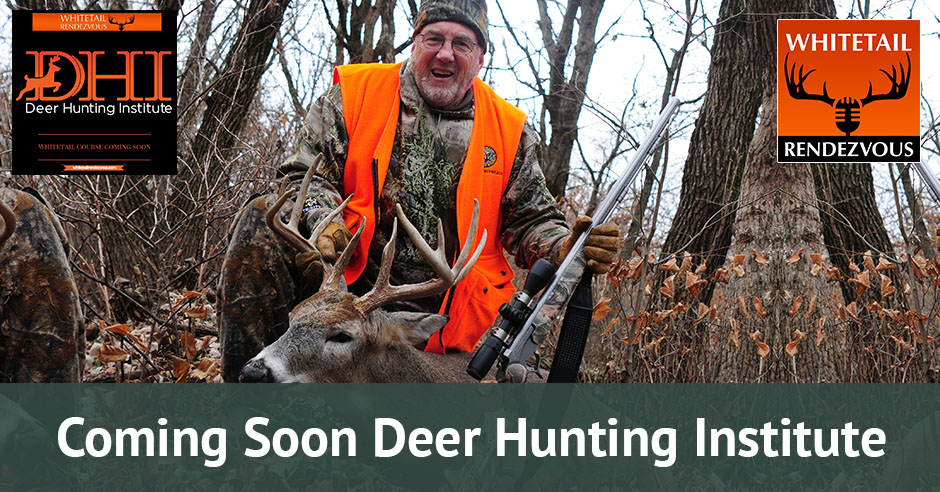
It’s inevitable to lose one’s passion in time probably due to a sudden transition or loss of interest. However, you can always redeem your fervor and start all over again. For hunters who got diverted or lost their way, Deer Hunting Institute got you covered. We are aimed to recruit, retain, and reactivate hunters throughout the country offering courses for every single level of hunters – whether you’re a beginner, an adult-onset hunter, or simply a mature buck hunter that just hasn’t been able to close that deal on that ghost buck on your property. In this episode, we go into the details of what to expect in this institute.
—
Listen to the podcast here:
Coming Soon Deer Hunting Institute
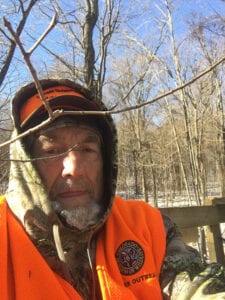 March 15th was the beginning of Whitetail Rendezvous. It isn’t when we launched. We launched on August 31st, 2015. Back in March of 2015, Bob Roark and I got together and decided to begin building and framing out and interviewing and doing all the things you have to do to launch a podcast. It took a while, but here it is and we’ve had over 600 episodes. We’ve had close to 400,000 downloads and I met some fantastic and interesting people and the stories and your stories have been fantastic. We shared a tremendous amount of information. Looking back, we realized that we wanted to do more in the industry. I’m creating Deer Hunting Institute. What is Deer Hunting Institute? It’s following the three R’s: Recruitment, Retention and Reactivation of hunters throughout the country. DNRs are having programs set up and people involved that are doing that because we need to recruit more hunters.
March 15th was the beginning of Whitetail Rendezvous. It isn’t when we launched. We launched on August 31st, 2015. Back in March of 2015, Bob Roark and I got together and decided to begin building and framing out and interviewing and doing all the things you have to do to launch a podcast. It took a while, but here it is and we’ve had over 600 episodes. We’ve had close to 400,000 downloads and I met some fantastic and interesting people and the stories and your stories have been fantastic. We shared a tremendous amount of information. Looking back, we realized that we wanted to do more in the industry. I’m creating Deer Hunting Institute. What is Deer Hunting Institute? It’s following the three R’s: Recruitment, Retention and Reactivation of hunters throughout the country. DNRs are having programs set up and people involved that are doing that because we need to recruit more hunters.
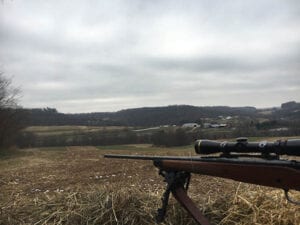
We need to retain the hunters that we have and we need to reactivate hunters that have left and have had kids or switched jobs or don’t hunt anymore. We want them back in the field. Deer Hunting Institute is aimed at doing that. I look at it as we have people that never hunted. We have beginner hunters. We have seasonal hunters. What’s a seasonal hunter? In Wisconsin, it’s a nine-day season and people get their gear out a week before. They hang it out of their backyard on their bibs and they get air washed. They sight their rifle in, shoot a couple of times at the range, and then they go sit on the stand they’ve been sitting on for a few years, several years, and many years. It’s a hunting tradition about heading up North and heading to the cabin.
If you're going to be a hunter, you got to know what the rules, statutes, and regulations for your state are. Share on XA lot of things have changed over a few decades that I’ve been hunting whitetails. The traditions are still there, but the way we hunt and how we hunt has all changed. Deer Hunting Institute is going to talk about that. We’re going to talk about lost in a deer hunting farce. That’s somebody that’s never hunted. If you take somebody that’s never hunted hunting the first time, it’s a whole new ballgame. Do you think about what is a hunter? Do you think about what is an adult-onset hunter? A lot of people are looking at hunting as ways of providing organic meat for their families. Rules do apply. If you’re going to be a hunter, you got to know what the rules, statutes, and regulations for your state are.
If you take somebody that's never hunted the first time, it’s a whole new ballgame. Share on XFinding a mentor is important to have somebody help you become a hunter and help you become a better hunter and lifelong relationship to develop over hunting. Dick Rogers took me to his family farm along the Baraboo River in Wisconsin back in 1966. We’ll be hunting the same farm that we did back then. That’s the hunting tradition. Choice of weapon, how do you want to hunt? Finding a place to hunt, it’s getting tougher and tougher. It used to be knocking on doors and you’d find a place to hunt. There are a lot of public lands out there. S47 came through and hopefully will become law and that opens up or protects our public land. There is public land, but you have to find them.
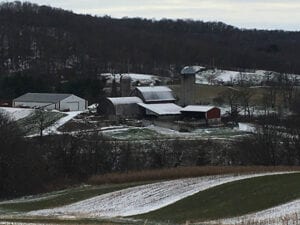
Scouting hunting locations are very important. Stand sites are equally as important. Stand access and exits, reading signs, and finally when to hunt. You think about all those things and each component is a story in itself. There are people who go to seminars this fall, winter, spring, summer and there are deer classics and expos. Iowa Deer Classic had some great speakers talking about deer vocalization. Art Helin of Own the Season TV is a great friend and he talks about how deer communicate. You start hearing that and for a beginner, that might be too much.
What Deer Hunting Institute’s first course is going to be is targeted at the person that’s never hunted or a beginner hunter. They’ve been out hunting rabbits or squirrels. Further courses are going to be about meat hunting, about mature buck hunting, and about trophy hunting and targeting the seasonal hunter. First, I’m going to share with you about stand sites and why they’re important. At the end of it, I’ll tell you how you can get Deer Hunting Institute consulting from me, a personal one-on-one session with me.
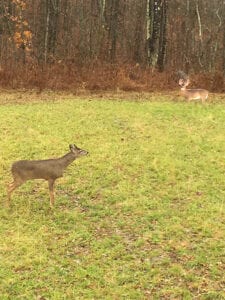 On this chapter of Deer Hunting Institute, we’re going to talk about stand sites. What’s a stand site? It might be you putting your butt on the ground against the tree and hanging out there, tree or a rock. It could be a hang on, a climber, a ladder stand, a ground blind, or a permanent box blind. There are a lot of things that we call stands, but the biggest thing is that it’s a place. We know where it is. We go there often or when the conditions are right. It’s a place that we know that deer should come by or come to at certain times of the day. Back in the wintertime, you did some scouting and you found out what the major trails were. You found some secondary trails and wandering trails, but the main trail especially where they intersect is always a good place for a stand given a specific time of year.
On this chapter of Deer Hunting Institute, we’re going to talk about stand sites. What’s a stand site? It might be you putting your butt on the ground against the tree and hanging out there, tree or a rock. It could be a hang on, a climber, a ladder stand, a ground blind, or a permanent box blind. There are a lot of things that we call stands, but the biggest thing is that it’s a place. We know where it is. We go there often or when the conditions are right. It’s a place that we know that deer should come by or come to at certain times of the day. Back in the wintertime, you did some scouting and you found out what the major trails were. You found some secondary trails and wandering trails, but the main trail especially where they intersect is always a good place for a stand given a specific time of year.
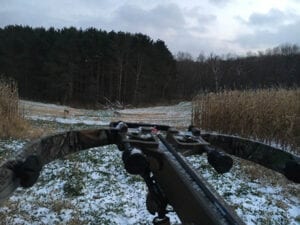 I wanted to introduce you to put a stand where you had the greatest opportunity. The lower average is going to run for you that you’re going to see buck or doe come within twenty to 30 yards from your stand. Realistically, unless you’re on an edge or unless you’re sitting on a field, that’s the length of a shot in the woods. That’s what it is. There are some situations where you might get a longer shot, but let’s say with the twenty to the 30-yard range on your stand. Going back to their travel corridors, we find two intersecting lines. Where are you going to put your stand? One, it has to be in a tree. If it’s a tree stand, that could hold the stand and it can hold your weight and offers you a good opportunity to shoot. If you’re right-handed, then you got to think about, “If I’m pulling and drawing my bow, where’s my best shot angles? Where’s the best situation that I can shoot and kill this deer?” When you get up in the stand, you have to figure that out. Why? When you set up your stand, you got to trim.
I wanted to introduce you to put a stand where you had the greatest opportunity. The lower average is going to run for you that you’re going to see buck or doe come within twenty to 30 yards from your stand. Realistically, unless you’re on an edge or unless you’re sitting on a field, that’s the length of a shot in the woods. That’s what it is. There are some situations where you might get a longer shot, but let’s say with the twenty to the 30-yard range on your stand. Going back to their travel corridors, we find two intersecting lines. Where are you going to put your stand? One, it has to be in a tree. If it’s a tree stand, that could hold the stand and it can hold your weight and offers you a good opportunity to shoot. If you’re right-handed, then you got to think about, “If I’m pulling and drawing my bow, where’s my best shot angles? Where’s the best situation that I can shoot and kill this deer?” When you get up in the stand, you have to figure that out. Why? When you set up your stand, you got to trim.
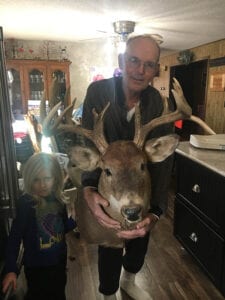 You have to pick a stand site that you can raise your bow, draw your bow, and then let loose your arrow in not a lot of time typically, and then hit your deer and harvest your deer. You have to figure out what deer and what time of day is that deer going to come through? Where is the wind direction? Where’s my concealment? All those things factor in because deer are smart. I’ve had deer, especially does, bust me because they know where my stand is and they come down the trail and they look right up to where the stand is and they see this blob there. I’m not moving. I might be sitting down but they still see me. They’re looking and they’ll make that head bob and foot stomp and all the rest of the things that they do. Stand sites are important. Travel corridors or main travel corridors, you got to figure out what side of the trail you want to put your stand.
You have to pick a stand site that you can raise your bow, draw your bow, and then let loose your arrow in not a lot of time typically, and then hit your deer and harvest your deer. You have to figure out what deer and what time of day is that deer going to come through? Where is the wind direction? Where’s my concealment? All those things factor in because deer are smart. I’ve had deer, especially does, bust me because they know where my stand is and they come down the trail and they look right up to where the stand is and they see this blob there. I’m not moving. I might be sitting down but they still see me. They’re looking and they’ll make that head bob and foot stomp and all the rest of the things that they do. Stand sites are important. Travel corridors or main travel corridors, you got to figure out what side of the trail you want to put your stand.
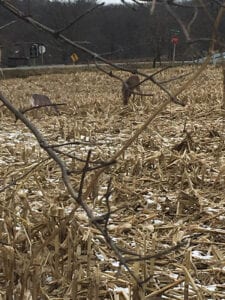 We have funnels. Funnels are exactly if you take a funnel that you’ve used to pour gas in your car or oil into your engine, you’ll know what a funnel is. It’s wide at the top and then it funnels down to narrow. That’s what a funnel does. The best way to see these are on Google or an aerial map of your property that you’re hunting. You can see what natural funnels are. They might start a quarter mile away, but they funnel down to the place that you want to put a stand in representation of the wind. Wherever the wind is coming from, you want to be downwind of that crossing or of that funnel, where the deer are going to come through. You’re going to be on either the left or the right of that funnel for the wind. Always keep that in mind.
We have funnels. Funnels are exactly if you take a funnel that you’ve used to pour gas in your car or oil into your engine, you’ll know what a funnel is. It’s wide at the top and then it funnels down to narrow. That’s what a funnel does. The best way to see these are on Google or an aerial map of your property that you’re hunting. You can see what natural funnels are. They might start a quarter mile away, but they funnel down to the place that you want to put a stand in representation of the wind. Wherever the wind is coming from, you want to be downwind of that crossing or of that funnel, where the deer are going to come through. You’re going to be on either the left or the right of that funnel for the wind. Always keep that in mind.
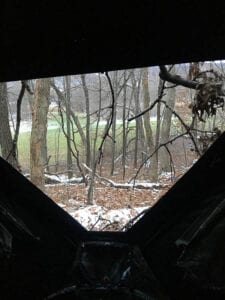 Next, we have pinch points. Pinch points might not be a funnel. Everything’s going hunky dory then all of a sudden there’s a rock there or there’s a big lake or there’s something either geographically or in the landscape that is causing a pinch point where the deer have to. They don’t have a choice. If they go one way, they drop off a cliff. They drop into a raging river. They might even drop into a swamp and you can see a lot of trails that will come down to a pinch point and they don’t necessarily want to go through that swamp. They certainly will but they might not want to because they’re heading to food. Pinch points are that. They could be ten yards in length or 50 yards in length and ten yards wide. It’s a pinch point where the deer have to come through that if they’re going to go through.
Next, we have pinch points. Pinch points might not be a funnel. Everything’s going hunky dory then all of a sudden there’s a rock there or there’s a big lake or there’s something either geographically or in the landscape that is causing a pinch point where the deer have to. They don’t have a choice. If they go one way, they drop off a cliff. They drop into a raging river. They might even drop into a swamp and you can see a lot of trails that will come down to a pinch point and they don’t necessarily want to go through that swamp. They certainly will but they might not want to because they’re heading to food. Pinch points are that. They could be ten yards in length or 50 yards in length and ten yards wide. It’s a pinch point where the deer have to come through that if they’re going to go through.
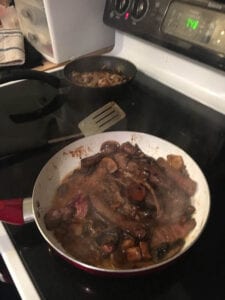
If they’re not, then they have to go way out of the way. With deer, they’re going to take the easiest, most effective and efficient route from bedding to food to water. Think about pinch points as it could be a short piece of real estate that they have to go through. Following that up are bottlenecks. Bottlenecks and pinch points are basically the same things. What is a bottleneck? It’s narrow at the top and then it widens out. It’s the same thing as pinch points. If somebody has a correction for me and wants to explain it better, reach out to me at DeerHuntingInstitute@gmail.com and I’d love to have a conversation.
Stand sites at food sources. Deer eat typically in the evening. They’d come off the food in the morning and then go back in the evening. There are times of days that you can see deer out in the fields during daylight hours. Typically, it’s those magic hours right after dawn and right after dusk. If you’re going to hunt near food sources in the morning, you want to be off the food source. You want to be in that transition zone. In the evening, you want to be closer to the food source because they’re going to come to a staging area and then they’re going to come on to the food source. The does and the fawns come first and then the young bucks come. The older bucks don’t come out until dark. They’re close but they’re watching to see what’s happening because they’re hungry too.
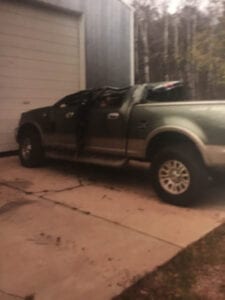 You have water sources. The axiom is food, cover, and water for whitetails. If you have all those three things on your property, you will have whitetails if they’re anywhere near around. Water sources, the heat of the day is a great time. They’ll get up briefly and go to water. They’ll go to the water after eating. They’ll go to the water after bedding all day. They will come to the water and you got to spend time on it. Put a trail camera up and monitor and see what days your local deer are coming to the water source, then you’d set up accordingly. Bedding cover is a great place to be, but you can’t get too close. It’s a fine line. Are 100 yards too close? Are 200 yards too close? It depends on the density of cover.
You have water sources. The axiom is food, cover, and water for whitetails. If you have all those three things on your property, you will have whitetails if they’re anywhere near around. Water sources, the heat of the day is a great time. They’ll get up briefly and go to water. They’ll go to the water after eating. They’ll go to the water after bedding all day. They will come to the water and you got to spend time on it. Put a trail camera up and monitor and see what days your local deer are coming to the water source, then you’d set up accordingly. Bedding cover is a great place to be, but you can’t get too close. It’s a fine line. Are 100 yards too close? Are 200 yards too close? It depends on the density of cover.
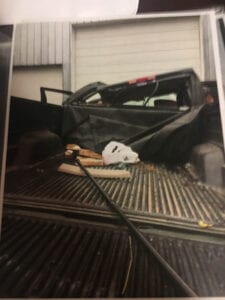 During the rut, I was 50 yards from a better doe. She was there and I never busted her because I watched my wind. I slipped in there. I knew she was there. It paid off because I had bucks coming through, checking and looking for her. She would come out of the cover every evening and I was waiting for the right buck to come through and to harvest that buck or to see what buck it is. Be careful how close you set up the bedding cover and be aware of how you access and how you set up. The last thing I want to talk about is saddles. They’re contour changes. You get a ridge and you have a dip. It might only be two feet of difference between the right and the left side. In the middle, you get a little saddle and deer love saddles. Elk love saddles. Big games of any type love saddles because it’s easier to get from one side to the other. With that, I’m going to wrap up stand sites. If you have any questions, reach out to me at DeerHuntingInstitute@gmail.com.
During the rut, I was 50 yards from a better doe. She was there and I never busted her because I watched my wind. I slipped in there. I knew she was there. It paid off because I had bucks coming through, checking and looking for her. She would come out of the cover every evening and I was waiting for the right buck to come through and to harvest that buck or to see what buck it is. Be careful how close you set up the bedding cover and be aware of how you access and how you set up. The last thing I want to talk about is saddles. They’re contour changes. You get a ridge and you have a dip. It might only be two feet of difference between the right and the left side. In the middle, you get a little saddle and deer love saddles. Elk love saddles. Big games of any type love saddles because it’s easier to get from one side to the other. With that, I’m going to wrap up stand sites. If you have any questions, reach out to me at DeerHuntingInstitute@gmail.com.
I hope you enjoyed module number ten, stand sites. I tried to give you the highlights. Deer Hunting Institute is a beginner’s course. I’ll get deeper into the subject matter either on a one-to-one consulting basis and that’s why I wanted to bring that up now. Anybody reading this can go to my PayPal account at SurferSC09@gmail.com and for $100 you can schedule one hour with me. We’ll talk about any module that you want to talk about for that time. I’m not going to go through the whole course because the course is going to be more than $100. I will talk about any specific segment of Deer Hunting Institute module for $100 if you’re interested in having a one-on-one conversation with somebody that has been hunting whitetails for a few decades, has hunted throughout North America and has been successful taking numerous deer.
My biggest is a buck out of Saskatchewan. That’s a great story in itself. It was four days at 22 degrees below zero. It was a tough mental hunt, not a tough physical hunt. If you’re interested in one-on-one consulting with Bruce Hutcheon about whitetail hunting and in the modules that I shared, please reach out to me on PayPal and book your time with me. You can do that at WhitetailRendezvous.com/Schedule. My PayPal account is SurferSC09@gmail.com and the fee for one-hour consultation is $100. Reach out to me. You can call me at (719) 640-0175 if you have questions. You can reach out to me at my email address at WhitetailRendezvous@gmail.com. I look forward to hearing from you and helping you become a better hunter.
Important Links:
- Dick Rogers – Whitetail Rendezvous episode with Dick Rogers
- DeerHuntingInstitute@gmail.com
- SurferSC09@gmail.com
- WhitetailRendezvous.com/Schedule
- WhitetailRendezvous@gmail.com
- Art Helin
- https://www.YouTube.com/Channel/UCCA9iFsR3yYlbcyPDVkXQQA
- http://WhitetailRendezvous.com/
- http://WhitetailRendezvous.com/survey
